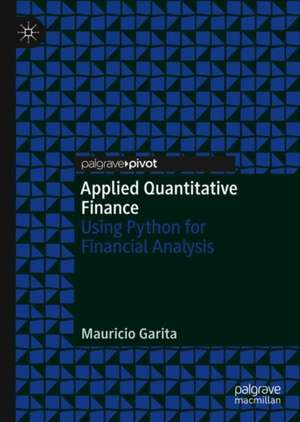Applied Quantitative Finance: Using Python for Financial Analysis
Autor Mauricio Garitaen Limba Engleză Hardback – 4 sep 2021
Preț: 490.07 lei
Nou
Puncte Express: 735
Preț estimativ în valută:
93.79€ • 101.84$ • 78.78£
93.79€ • 101.84$ • 78.78£
Carte tipărită la comandă
Livrare economică 23 aprilie-07 mai
Preluare comenzi: 021 569.72.76
Specificații
ISBN-13: 9783030291402
ISBN-10: 3030291405
Pagini: 46
Ilustrații: XXVI, 240 p. 613 illus., 601 illus. in color.
Dimensiuni: 148 x 210 mm
Greutate: 0.47 kg
Ediția:1st ed. 2021
Editura: Springer International Publishing
Colecția Palgrave Pivot
Locul publicării:Cham, Switzerland
ISBN-10: 3030291405
Pagini: 46
Ilustrații: XXVI, 240 p. 613 illus., 601 illus. in color.
Dimensiuni: 148 x 210 mm
Greutate: 0.47 kg
Ediția:1st ed. 2021
Editura: Springer International Publishing
Colecția Palgrave Pivot
Locul publicării:Cham, Switzerland
Cuprins
1. How to use python?.- 2. Using data structures in Python.- 3. Using Data in Python.- 4. Descriptive statistics using Python.- 5. Statistical approach to multiple variables.- 6. Comparing stocks between companies.- 7. Porfolio and Risk.- 8. Value at Risk.
Notă biografică
Mauricio Garita is an academic, a writer and an economist that has centered his career in the combination of finance and economics with the use of Python. He obtained his first PhD in Political Science and Sociology from the Universidad Pontificia de Salamanca, Spain with a thesis centered on game theory and economic development. Prior to obtaining his PhD, he completed a Master of Science from Manchester Business School, UK and a secondary Master’s in Asset Management from the Instituto de Estudios Bursátiles de la Universidad Complutense, Spain.
As an academic, his research is focused on financial issues, economics and competitiveness in Latin America with a special focus in Central America. He has written books and articles on topics such as business in Latin America, the economic impact of the Civil War in Guatemala, the fiscal impact of reforms in Latin America and the impact of the financial crisis in Central America. As a professor he centers his coursesin the areas of economics, project valuation and financial analysis.
During his professional career he has worked with organizations such as the World Bank, the Central American Institute of Fiscal Studies, the Secretariat for Central America Economic Integration, Transparency International and on financial consulting. Currently he works at Universidad Francisco Marroquin as a director of the master’s in finance program at the university business school. Before he worked at the finance department at the Universidad del Valle de Guatemala where he assisted in both the creation of the Master’s in Advanced Finance and a collaboration on with the Advanced Risk Portfolio Management (ARPM) program.
As an academic, his research is focused on financial issues, economics and competitiveness in Latin America with a special focus in Central America. He has written books and articles on topics such as business in Latin America, the economic impact of the Civil War in Guatemala, the fiscal impact of reforms in Latin America and the impact of the financial crisis in Central America. As a professor he centers his coursesin the areas of economics, project valuation and financial analysis.
During his professional career he has worked with organizations such as the World Bank, the Central American Institute of Fiscal Studies, the Secretariat for Central America Economic Integration, Transparency International and on financial consulting. Currently he works at Universidad Francisco Marroquin as a director of the master’s in finance program at the university business school. Before he worked at the finance department at the Universidad del Valle de Guatemala where he assisted in both the creation of the Master’s in Advanced Finance and a collaboration on with the Advanced Risk Portfolio Management (ARPM) program.
Textul de pe ultima copertă
This book provides conceptual knowledge on quantitative finance and a hands-on experience using Python. It begins with a description of concepts prior to the application of Python with the purpose of understanding how to compute and also the interpretation of the results. The book will satisfy the lack of information concerning Python, a language that is more and more relevant in the financial arena due to big data. This will lead to a better understanding of advance finance as it gives a descriptive process for students, academics and practitioners.
Caracteristici
Provides conceptual knowledge on quantitative finance and a theoretical background prior to the application of Python Offers a hands-on experience of implementing and using Python Focuses on advanced financial analysis in an academic yet descriptive manner
